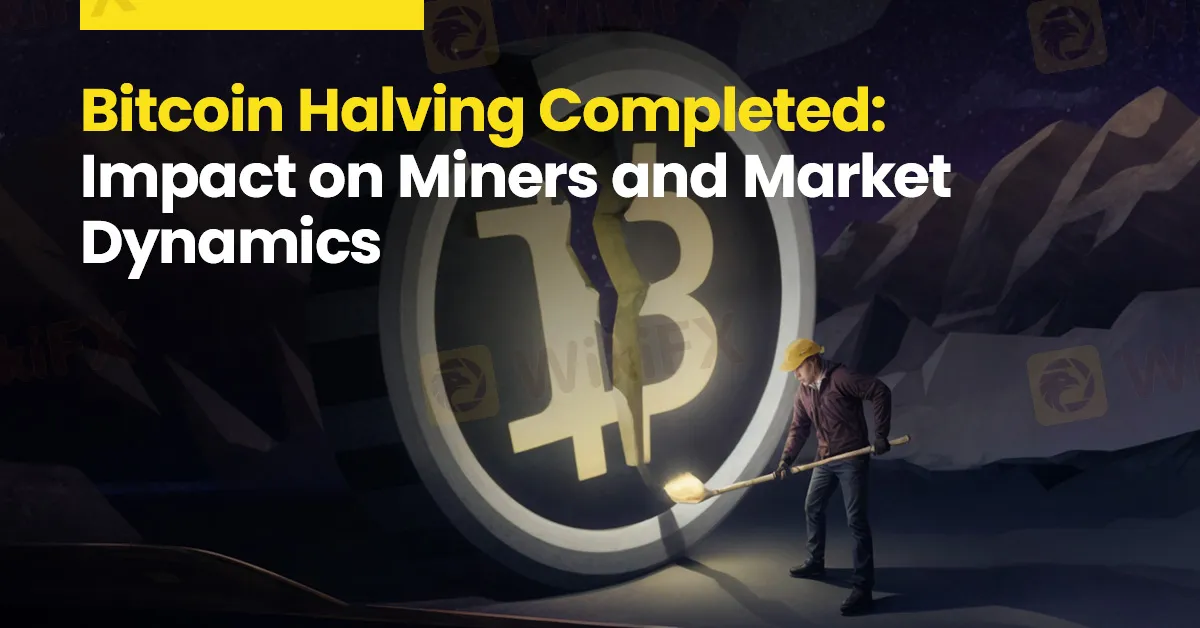简体中文
繁體中文
English
Pусский
日本語
ภาษาไทย
Tiếng Việt
Bahasa Indonesia
Español
हिन्दी
Filippiiniläinen
Français
Deutsch
Português
Türkçe
한국어
العربية
Bitcoin Halving Completed: Impact on Miners and Market Dynamics
Abstract:The completion of the much-anticipated Bitcoin halving event has implications for the digital currency's ecosystem, particularly affecting companies involved in maintaining its operations, as it halves the reward for miners every four years to ensure the currency's integrity and scarcity.

The completion of the highly anticipated Bitcoin software update known as the “halving” has potentially impacted companies that ensure the smooth and secure functioning of the digital currency.
Scheduled once every four years, this event has halved the mining reward, the Bitcoin amount released to miners for validating transactions. The change took effect at 8:10 pm New York time on Friday, according to data from mempool.space and Blockchain.com. Despite this, Bitcoin's price remained relatively stable around $64,000.
This adjustment in rewards was preordained by Bitcoin's blockchain code to maintain a maximum cap of 21 million Bitcoins and prevent inflation. Satoshi Nakamoto, the purported creator of Bitcoin, introduced the halving mechanism. With this recent halving, the daily reward for miners has decreased to 450 Bitcoin from 900.

Advocates of Bitcoin anticipate this halving to positively influence the ongoing bull market by reducing the supply of new tokens, coinciding with increased demand from new exchange-traded funds. Figures like MicroStrategy Inc chairman Michael Saylor advocate Bitcoin as a superior store of value compared to fiat currencies susceptible to inflation.
However, market analysts, including those from JPMorgan Chase & Co and Deutsche Bank AG, suggested that the halving's impact was already factored into the market.
According to data from CryptoQuant, following the halving, Bitcoin's price remained relatively stable, while the average transaction fee on the network experienced a surge of over 730% to $250 before stabilizing at $164.
Each halving diminishes the dilutive effect of Bitcoin mining. Bloomberg data shows that while the first halving led to the issuance of tokens equivalent to 50% of Bitcoin outstanding at the time, the upcoming cycle will only introduce 3.3% new supply.
Near-term bullishness towards Bitcoin might face challenges from macroeconomic factors like signals from the Federal Reserve and geopolitical tensions in the Middle East, according to Edward Chin, co-founder of Parataxis Capital.
The primary impact of the halving is expected on Bitcoin mining companies rather than the cryptocurrency's price itself. This blockchain update is forecasted to reduce billions of dollars in annual revenue for miners, although continued price increases could mitigate this effect.
JPMorgan anticipates consolidation in the mining sector, with publicly-listed firms poised to gain market share due to better access to funding, particularly equity financing.
Previous halvings occurred without significant disruptions to the Bitcoin blockchain's functionality. The next halving is scheduled for 2028, reducing the reward to 1.5625 Bitcoin for successfully processing a block, with an average block processing time of around 10 minutes.
There are projected to be 64 Bitcoin halvings before reaching the 21 million cap around 2140, after which new token issuance will cease, and miners will rely solely on transaction fees as a revenue source. However, rising transaction fees currently constitute only a small portion of total miner revenue.

Disclaimer:
The views in this article only represent the author's personal views, and do not constitute investment advice on this platform. This platform does not guarantee the accuracy, completeness and timeliness of the information in the article, and will not be liable for any loss caused by the use of or reliance on the information in the article.
Read more

Coinbase Under Scrutiny Amid Wrapped Bitcoin Delisting Controversy
Coinbase has come under fire after announcing its decision to delist Wrapped Bitcoin (wBTC), a move critics claim could be driven by competitive interests. The delisting, set to take effect on 19 December, has sparked allegations of market manipulation and concerns about fairness in the cryptocurrency ecosystem.

Solana Soars to All-Time High, Hits $264 on Coinbase
Solana hits $264 on Coinbase, breaking its 3-year high with an 11% daily surge. Learn what’s driving SOL's meteoric rise and the crypto market rally.

Bitcoin Nears $100,000: A Triumph of Optimism or a Warning Sign?
Bitcoin’s meteoric rise continues to capture global attention as its price recently surpassed the $99,000 mark, briefly approaching the $100,000 milestone. This unprecedented rally has led market sentiment to reach a state of “extreme greed,” according to the Fear and Greed Index. Analysts suggest that the market may be entering overheated territory, raising questions about sustainability amidst ongoing enthusiasm.

FCA Alerts Traders to New List of Unregulated and Clone Brokers
Protect your investments! Learn about unregulated firms flagged by the FCA and discover how WikiFX helps traders avoid scams and choose legitimate brokers.
WikiFX Broker
Latest News
eToro Expands Nationwide Access with New York Launch
Webull Partners with Coinbase to Offer Crypto Futures
Why Is UK Inflation Rising Again Despite Recent Lows?
Hackers Charged for $11M Crypto Theft Using SIM-Swaps
Role of Central Banks in the FX Market
FCA Alerts Against Sydney FX
What Makes Cross-Border Payments Easier Than Ever?
Trader Exposes Unethical Practices by STP Trading
Interactive Brokers Launches Tax-Friendly PEA Accounts in France
Google Warns of New Deepfake Scams and Crypto Fraud
Currency Calculator


